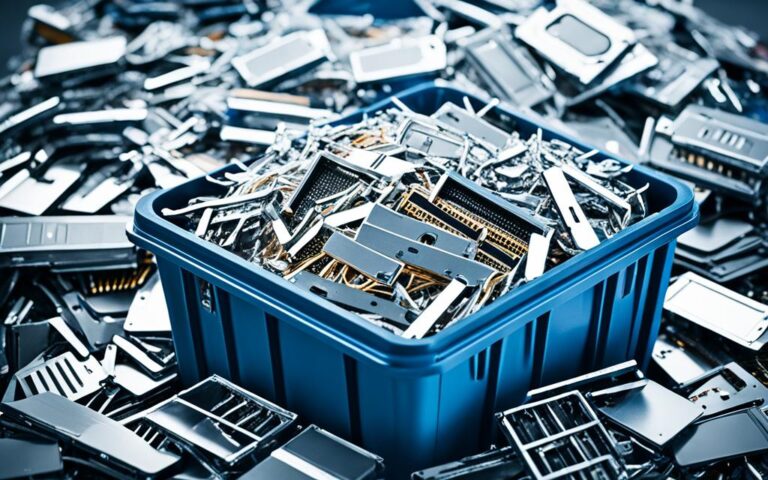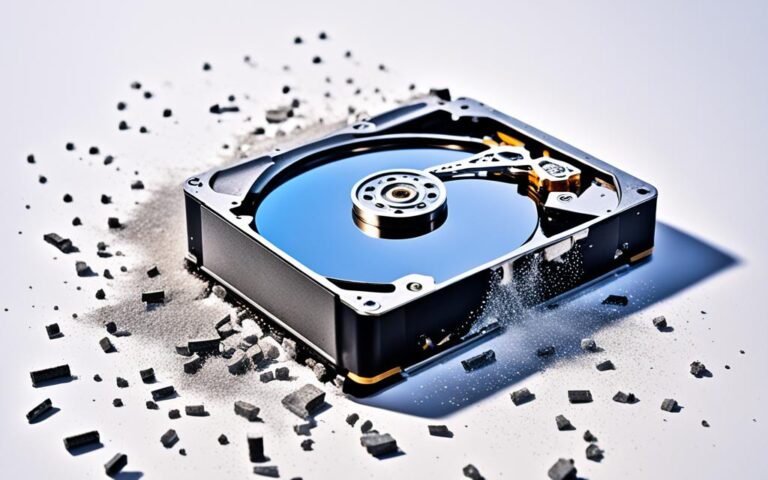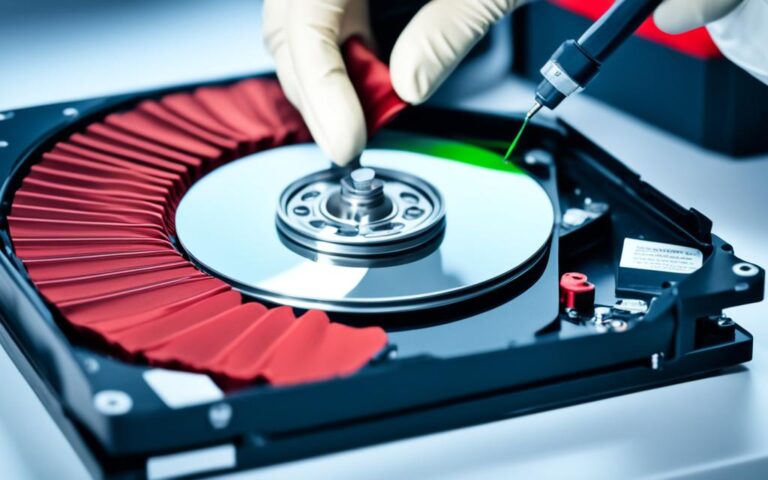The Economics of Data Destruction: Cost vs. Security
Effective data destruction is essential for businesses to mitigate the risks associated with sensitive information. It requires a delicate balance between cost efficiency and stringent security standards.
Data destruction economics play a crucial role in determining the most viable method for businesses to dispose of their data storage devices. The stockpiling of hard disk drives (HDDs) and other media can potentially expose businesses to inadvertent disclosures and data breaches.
In-house data destruction offers a safer and more cost-effective alternative to outsourcing. By eliminating the risk of handing media to third-party contractors, businesses can ensure strict adherence to internal security protocols.
It is important to note that recycled media can still contain sensitive data if not properly destroyed. Therefore, organizations must employ robust data destruction methods to avoid any potential liabilities.
In the next section, we will delve into the importance of data destruction in UK businesses and the increasing risks associated with mishandled data.
The Importance of Data Destruction in UK Businesses
Businesses worldwide store highly sensitive information on drives without proper protocols for data destruction. This issue is prominent in data center operators who struggle to securely destroy end-of-life media. The volume of data makes it difficult to maintain security and oversight.
Data breaches can result in fines and reputational damage. Regulations regarding data handling and destruction are becoming more stringent, especially for organizations handling classified and personally identifiable information. Cyberattacks and data breaches are on the rise, highlighting the need for effective data destruction strategies.
Without proper data destruction measures, UK businesses face significant liability risks. The mishandling of sensitive data can have severe consequences, not only legally but also financially and reputationally. It is essential for organizations to prioritize data destruction to mitigate these risks.
“Effective data destruction is a crucial aspect of safeguarding sensitive information and maintaining compliance with data protection regulations.”
In-house data destruction offers UK businesses a proactive approach to protect sensitive data. By establishing proper protocols for data destruction, organizations can ensure that end-of-life media is securely and irreversibly destroyed, minimizing the risk of data breaches and unauthorized access.
The necessity for data destruction is further reinforced by the increasing sophistication of cyber threats. Hackers are constantly finding new ways to exploit vulnerabilities in data storage devices. Without secure data destruction, organizations expose themselves to potential breaches and the theft or misuse of valuable information.
Implementing robust data destruction practices not only protects UK businesses from liability but also demonstrates a commitment to data security and customer trust. By effectively destroying sensitive data, organizations can safeguard their reputation while ensuring compliance with relevant regulations.
Key Points:
- Businesses worldwide store sensitive information without proper data destruction protocols.
- Data center operators struggle to securely destroy end-of-life media.
- Data breaches can result in fines and reputational damage.
- Regulations regarding data handling and destruction are becoming more stringent.
- Cyberattacks and data breaches are on the rise.
The Cost Analysis of Data Destruction
When it comes to data destruction, businesses need to carefully consider the cost implications. The average cost of destroying a hard drive is around $15 per drive. However, this cost can vary depending on several factors, including the type of media destruction equipment used.
Let’s take a closer look at the different cost considerations and break-even points for data destruction at various volume levels:
- Low-volume media destruction: The break-even point for the cost of the equipment is 433 drives. This means that if a business destroys fewer than 433 drives, it may be more cost-effective to outsource the data destruction instead of investing in their own equipment.
- Enterprise-level media destruction: The break-even point for the cost of the equipment is 2,666 drives. Organizations handling a higher volume of drives may find it more financially viable to have their own in-house data destruction equipment.
- Data center level destruction: The break-even point for the cost of the equipment is 4,106 drives. Data centers, which often deal with a large number of drives, may find it economical to invest in data destruction equipment and handle the process internally.
Phiston Technologies offers cost-effective solutions for data destruction, providing businesses with a positive return on investment over time. With their industry-leading products, businesses can efficiently and securely destroy sensitive data while managing costs effectively.
The Importance of Data Destruction
“Data destruction is not only vital for data security, but it also ensures compliance with stringent data protection regulations. By investing in the right data destruction solutions, businesses can protect themselves from potential fines, reputational damage, and the loss of customer trust.”
With the growing risks of cybercrime and data breaches, it’s crucial that businesses prioritize secure data destruction to safeguard their sensitive information. Phiston Technologies offers state-of-the-art solutions that enable businesses to meet the increasing demands of data destruction while ensuring the highest level of security.
Next, we’ll explore the advantages of Phiston Technologies and why they are an industry leader in on-site data destruction.
The Advantages of Phiston Technologies for Data Destruction
Phiston Technologies is an industry leader in providing innovative data destruction solutions. With a wide range of commercial-grade products, they dominate the information security market for media destroyers.
Phiston Technologies’ products are known for their exceptional performance and reliability. Built to meet stringent industry standards for media destruction and sanitization, these devices ensure that sensitive data is completely eradicated, preventing any potential breaches.
One of the key advantages of Phiston Technologies is their experience serving diverse industries. From homeland security and military organizations to finance and healthcare sectors, their solutions have been trusted by a wide range of clients to securely destroy their sensitive data.
Phiston Technologies’ devices are deployed globally, delivering on-site data destruction for organizations of all sizes. This ensures that data remains secure without the need to rely on external contractors, minimizing potential risks and liabilities.
As an industry leader, Phiston Technologies places a strong emphasis on research and development to continuously enhance their data destruction solutions. Their robust and powerful devices are designed to cater to the evolving needs of the information security market.
Benefits of Phiston Technologies for Data Destruction:
- Industry-leading expertise in data destruction
- Comprehensive range of commercial-grade products
- Global deployment for on-site data destruction
- Reliable and powerful devices that meet industry standards
- Proven track record serving diverse industries
Phiston Technologies’ commitment to delivering cutting-edge data destruction solutions has solidified its position as an industry leader. Organizations can trust them to safeguard their sensitive data, protect their reputation, and comply with stringent data security regulations.
Phiston Technologies sets the standard for secure data destruction with their robust and reliable solutions. Their industry-leading expertise and diverse client base position them as the go-to choice for organizations looking to ensure the complete eradication of sensitive data.
| Advantages | Phiston Technologies |
|---|---|
| Reliability | ✓ |
| Industry expertise | ✓ |
| Comprehensive product range | ✓ |
| Global deployment | ✓ |
| Meeting industry standards | ✓ |
The Growing Impact of Cybercrime and Ransomware
In today’s digital landscape, cybercrime has become a pervasive and costly threat to businesses and individuals alike. The increasing interconnectedness of our world has paved the way for an ever-expanding cyberattack surface, leaving organizations vulnerable to malicious actors seeking to exploit vulnerabilities for personal gain. The repercussions of cybercrime extend far beyond financial losses, with the potential to cause irreparable damage to a company’s reputation and customer trust.
Cybercrime Costs
The economic impact of cybercrime is staggering. By 2025, it is projected that cybercrime costs will reach a staggering £10.5 trillion annually. This includes the expenses associated with investigating and mitigating cyberattacks, as well as the financial burden of recovering from data breaches and other malicious activities.
Ransomware Damages
Ransomware, a type of malicious software that encrypts a victim’s data and demands a ransom for its release, has emerged as a particularly insidious form of cybercrime. It is estimated that ransomware damages will increase to £20 billion by 2021. The impact is felt not only by large corporations but also by small businesses and individuals who may lack the resources to recover from such attacks.
The Expanding Cyberattack Surface
The cyberattack surface has evolved alongside technological advancements, expanding beyond traditional targets such as computers. Today, cybercriminals exploit vulnerabilities in a wide range of systems, including Internet of Things (IoT) devices, power grids, autonomous vehicles, and even human targets. The increasing amount of sensitive data stored in the cloud and the proliferation of networked devices provide cybercriminals with numerous entry points to launch their attacks.
The Need for Enhanced Cybersecurity
As cybercrime continues to grow in scale and sophistication, organizations are investing significant resources in cybersecurity measures. However, despite increased spending, cyberattacks continue to outpace defense measures. Small businesses, in particular, are vulnerable to phishing attacks—an attack vector frequently employed by cybercriminals. It is essential for organizations to stay proactive in implementing robust cybersecurity protocols to safeguard their data and minimize the risk of falling victim to cybercrime.
Protecting Against Cyber Threats
To protect against the growing threat of cybercrime and ransomware damages, organizations must take a multi-faceted approach. This includes:
- Implementing strong security measures such as firewalls, antivirus software, and encrypted communications.
- Regularly backing up critical data to secure offsite locations.
- Training employees on cybersecurity best practices to minimize the risk of falling victim to phishing attacks.
- Conducting thorough risk assessments to identify vulnerabilities and mitigate potential threats.
| Cybercrime Costs | Ransomware Damages |
|---|---|
| £10.5 trillion annually by 2025 | £20 billion by 2021 |
As the cyber threat landscape continues to evolve, organizations must remain vigilant and proactive in their efforts to combat cybercrime. By implementing robust cybersecurity measures and staying informed about emerging threats, businesses can effectively safeguard their data, finances, and reputation.
Conclusion
Data destruction plays a crucial role in ensuring cybersecurity for businesses in the UK. With the ever-growing threat of cybercrime and data breaches, organizations must prioritize secure data destruction to safeguard their sensitive information. By implementing in-house data destruction practices, businesses can benefit from both cost-effectiveness and enhanced security.
Outsourcing data destruction to third-party contractors can pose risks, as it involves handing over media to external entities. In-house destruction eliminates this risk, providing businesses with greater control and oversight over the process. Furthermore, recycled media can still contain sensitive data if not properly destroyed, underscoring the importance of implementing stringent data destruction protocols.
When it comes to secure data destruction, Phiston Technologies stands out as an industry leader. Their range of commercial-grade products meets the highest standards for media destruction and sanitization, making them a trusted choice for organizations across various industries, including finance, military, and homeland security. Phiston Technologies’ global deployment ensures that businesses of all sizes can access secure on-site data destruction solutions.
As cybercrime continues to evolve and pose significant threats, businesses cannot afford to overlook the importance of effective data destruction methods in safeguarding their data and reputation. By investing in secure data destruction practices, organizations can mitigate the risks of cyberattacks and data breaches, ensuring the integrity and confidentiality of their sensitive information.
FAQ
What is the importance of data destruction for businesses in the UK?
Data destruction is crucial for UK businesses to protect sensitive information, mitigate liability, and reduce the risks of data breaches and cybercrimes.
Why should businesses prioritize in-house data destruction?
In-house data destruction offers a safer and more cost-effective alternative to outsourcing, eliminating the risk of handing media to third-party contractors.
Can recycled media still contain sensitive data?
Yes, if not properly destroyed, recycled media can still contain sensitive data, making it important to ensure proper data destruction measures.
What are the advantages of using Phiston Technologies for data destruction?
Phiston Technologies offers industry-leading solutions that are commercial grade, powerful, rugged, and meet industry standards for media destruction and sanitization. Their devices are deployed globally, ensuring secure data destruction for organizations of all sizes.
How does the cost of data destruction vary?
The cost of destroying a hard drive can vary, with an average cost of per drive destroyed. The cost depends on factors such as the required level of security and resources, as well as the type of media destruction equipment used.
What is the break-even point for the cost of data destruction equipment?
For low volume media destruction, the break-even point for the cost of the equipment is 433 drives. For enterprise-level media destruction, the break-even point is 2,666 drives. And for data center level destruction, the break-even point is 4,106 drives.
What is the impact of cybercrime and ransomware?
Cybercrime costs are projected to reach .5 trillion annually by 2025, and ransomware damages are predicted to increase to billion by 2021. The growing attack surface, including computers, people, cars, power grids, and more, highlights the need for effective cybersecurity measures.
Why is data destruction crucial for cybersecurity?
Data destruction is a critical aspect of cybersecurity as it helps businesses protect their sensitive information, maintain compliance with regulations, and safeguard their data and reputation from the increasing risks of cybercrime and data breaches.













